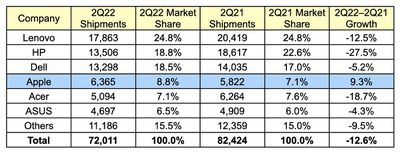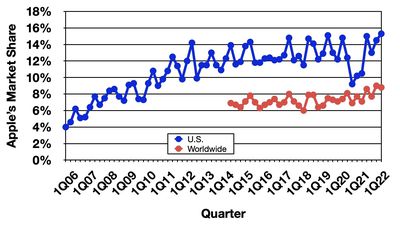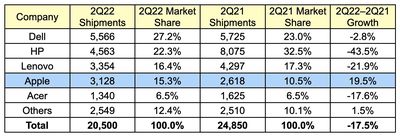Apple's worldwide Mac shipments were up in the second quarter of 2022, according to new PC shipping estimates shared today by Gartner. Apple shipped an estimated 6.4 million Macs during the quarter, up from 5.8 million in the year-ago quarter, marking 9.3 percent year-over-year growth.

Apple continued to be the number four vendor during the quarter with 8.8 percent market share. Apple continued to trail behind Lenovo, HP, and Dell, with 17.9 million, 13.5 million, and 13.3 million shipments, respectively. Acer and ASUS trailed behind Apple with 5.1 million and 4.7 million PCs shipped, respectively.
Mac shipments were up despite severe supply constraints that saw some MacBook Pro models delayed for multiple weeks or even months, and Apple was the only vendor to see positive growth. All other PC vendors saw a decline in shipments during the quarter due to supply chain issues.

Overall, there were an estimated 72 million PCs shipped during the quarter, down from 82.4 million in the year-ago quarter, a decline of 12.6 percent. Gartner says that this is the sharpest decline the global PC market has seen in nine years.
In the United States, Apple shipped an estimated 3.1 million Macs in Q2 2022, up 19.5 percent from the 2.6 million it shipped in the first quarter of 2021. Dell, HP, and Lenovo beat out Apple in terms of shipments, selling 5.6, 4.6, and 3.4 million PCs, respectively.

IDC released its own shipping estimates this morning, painting a more grim picture of Apple's Mac sales during the quarter. According to IDC, Apple shipped just 4.8 million Macs in Q2 2022, marking a year-over-year decline of 22.5 percent. IDC believes that overall PC shipments were down a total of 15.3 percent during the quarter.
Data shared by Gartner and IDC is estimated and not necessarily reflective of Apple's actual sales, and the numbers tend to fluctuate quite a bit over time, which is why the estimates are so different. Estimated data used to be able to be confirmed when Apple provided quarterly earnings results with actual Mac sales information, but Apple no longer breaks out unit sales for the iPhone, iPad, and Mac, making it impossible to determine exact sales numbers.























